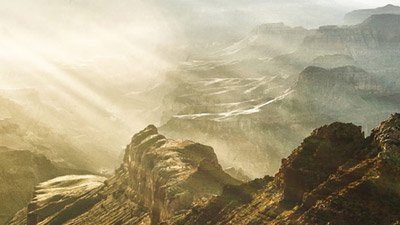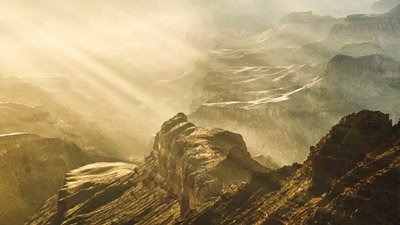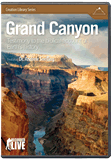Feedback: Grand Canyon Elevation
Is the higher elevation of the rim in the center of the Grand Canyon evidence of catastrophic formation? Dr. Andrew Snelling, AiG–U.S., explains.
I have heard that, in the center of the Grand Canyon, the rim is higher in elevation than the rim at either end of the canyon. This was used as another evidence for a catastrophic formation of the canyon, since the Colorado River (like all rivers) can only flow downhill. Is this actually good evidence to use? It seems that, assuming the evolutionists were right about a slow formation of the canyon, there would have been plenty of time for erosion to create the change in elevation that we see today. Thus, young-earth creationists should not use the above argument, since it would only support their theory given their own time scale.
Thank you for your help!
– B.
Dear B.,
Thanks for your enquiry. I will do my best to answer your questions succinctly, but you will find a more complete answer, with full details and diagrams, in volume 3 of the New Answers Book, which is available from our online bookstore.
I believe there are two important additional pieces of information that need to be considered. First, creationists and evolutionists alike agree that the plateau through which the Colorado River now flows (via the Grand Canyon) was uplifted and put in place before the Grand Canyon existed and before the Colorado River flowed through it. And second, the consensus is that once the plateau was in place, instead of the ancestral Colorado River flowing around that plateau to avoid having to flow uphill, the Grand Canyon was carved right through that plateau. Thus, the Colorado River now makes a sharp right turn at the edge of the plateau to flow through the plateau and the Grand Canyon. These are the two mysteries that the slow-and-gradual evolutionary model for formation of the Grand Canyon cannot explain. This is why conventional geologists and others are totally mystified.
You are quite correct that the center of the plateau through which the Grand Canyon has been cut is higher in elevation than the rims at either end of the canyon. Of course, this means if the plateau was there before the Colorado River, then the Colorado River would have had to flow uphill to carve out the Grand Canyon! This remains powerful evidence that the Grand Canyon had to be carved out catastrophically because no slow-and-gradual scenario can explain its formation. That’s why the canyon is a mystery to evolutionists.
Grand Canyon is a puzzle, a mystery, an enigma. It appears to have been carved through an uplifted plateau, ignores fault lines, may have been born by a river that once flowed the other way, is possibly quite old or quite young – or both – and is set within a more mature landscape. (Wayne Ranney, Carving Grand Canyon: Evidence, Theories, and Mystery, Grand Canyon Association, AZ, 2005, p.19)
The evolutionists are stumped because there was no river there when the plateau was uplifted. However, if the plateau was uplifted at the end of the Flood, then the floodwaters rapidly draining off the emerging land surface would have stripped the plateau bare to give it its flat top. Everyone generally agrees that sheet erosion on a massive scale has removed thousands of feet of strata from above the rims of the canyon—strata that outcrops to the north and south of the Grand Canyon, for example, in Zion National Park to the north and Flagstaff, Arizona, to the south.
Some gully erosion would have occurred across the plateau as the last of the floodwater drained west toward the Pacific Ocean. However, the floodwater flowing from east to west would have been blocked by the rising plateau and would have been dammed up to form a huge lake system. With heavy rainfall occurring intermittently in the early years after the Flood due to the climate instability, the water level in that huge lake system would have continued to rise until it reached the top of the natural dam wall. As the water then began to flow across the plateau, it would have utilized any gullying already eroded there, and the volume of water cutting through pre-existing gullies would have increased as further erosion started to rapidly occur. The net result would have been a catastrophic down-cutting into the plateau to form the Grand Canyon. The final “trickle” of leftover waters would have then become the Colorado River.
In contrast, a longer, slow-and-gradual timescale would not allow this to happen. If it were feasible, the evolutionists would argue the plateau was uplifted slowly so that the Colorado River eroding through the plateau could keep pace with the slow uplift. But it is simply not reasonable for them to argue that, as the evidence does not support it. As I said before, it is agreed upon that the plateau was uplifted first, and the Colorado River now does a sharp right-hand turn into the plateau and through the Grand Canyon. Both of these problems mystify the evolutionists. That’s why the catastrophic formation of the canyon is still a valid argument based on sound evidence. And the fact that the plateau is higher in the center is icing on the cake.
I trust these brief comments are a help to you. Thanks again for your enquiry. Be sure to read the full answer in the New Answers Book 3.
Yours sincerely in Christ,
Dr. Andrew Snelling, AiG–U.S.
Recommended Resources

Answers in Genesis is an apologetics ministry, dedicated to helping Christians defend their faith and proclaim the good news of Jesus Christ.
- Customer Service 800.778.3390
- Available Monday–Friday | 9 AM–5 PM ET
- © 2025 Answers in Genesis






